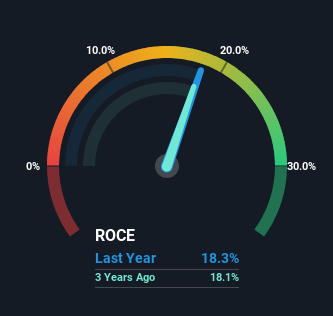Be Wary Of Prince Pipes and Fittings (NSE:PRINCEPIPE) And Its Returns On Capital
If we want to find a potential multi-bagger, often there are underlying trends that can provide clues. Ideally, a business will show two trends; firstly a growing return on capital employed (ROCE) and secondly, an increasing amount of capital employed. If you see this, it typically means it's a company with a great business model and plenty of profitable reinvestment opportunities. In light of that, when we looked at Prince Pipes and Fittings (NSE:PRINCEPIPE) and its ROCE trend, we weren't exactly thrilled.
Understanding Return On Capital Employed (ROCE)
Just to clarify if you're unsure, ROCE is a metric for evaluating how much pre-tax income (in percentage terms) a company earns on the capital invested in its business. Analysts use this formula to calculate it for Prince Pipes and Fittings:
Return on Capital Employed = Earnings Before Interest and Tax (EBIT) ÷ (Total Assets - Current Liabilities)
0.18 = ₹2.7b ÷ (₹19b - ₹4.2b) (Based on the trailing twelve months to September 2023).
Therefore, Prince Pipes and Fittings has an ROCE of 18%. That's a relatively normal return on capital, and it's around the 17% generated by the Building industry.
Check out our latest analysis for Prince Pipes and Fittings

In the above chart we have measured Prince Pipes and Fittings' prior ROCE against its prior performance, but the future is arguably more important. If you'd like, you can check out the forecasts from the analysts covering Prince Pipes and Fittings here for free.
What The Trend Of ROCE Can Tell Us
In terms of Prince Pipes and Fittings' historical ROCE movements, the trend isn't fantastic. Around five years ago the returns on capital were 26%, but since then they've fallen to 18%. Meanwhile, the business is utilizing more capital but this hasn't moved the needle much in terms of sales in the past 12 months, so this could reflect longer term investments. It may take some time before the company starts to see any change in earnings from these investments.
On a side note, Prince Pipes and Fittings has done well to pay down its current liabilities to 22% of total assets. So we could link some of this to the decrease in ROCE. Effectively this means their suppliers or short-term creditors are funding less of the business, which reduces some elements of risk. Some would claim this reduces the business' efficiency at generating ROCE since it is now funding more of the operations with its own money.
The Key Takeaway
Bringing it all together, while we're somewhat encouraged by Prince Pipes and Fittings' reinvestment in its own business, we're aware that returns are shrinking. Investors must think there's better things to come because the stock has knocked it out of the park, delivering a 168% gain to shareholders who have held over the last three years. Ultimately, if the underlying trends persist, we wouldn't hold our breath on it being a multi-bagger going forward.
While Prince Pipes and Fittings doesn't shine too bright in this respect, it's still worth seeing if the company is trading at attractive prices. You can find that out with our FREE intrinsic value estimation on our platform.
If you want to search for solid companies with great earnings, check out this free list of companies with good balance sheets and impressive returns on equity.
New: Manage All Your Stock Portfolios in One Place
We've created the ultimate portfolio companion for stock investors, and it's free.
• Connect an unlimited number of Portfolios and see your total in one currency
• Be alerted to new Warning Signs or Risks via email or mobile
• Track the Fair Value of your stocks
Have feedback on this article? Concerned about the content? Get in touch with us directly. Alternatively, email editorial-team (at) simplywallst.com.
This article by Simply Wall St is general in nature. We provide commentary based on historical data and analyst forecasts only using an unbiased methodology and our articles are not intended to be financial advice. It does not constitute a recommendation to buy or sell any stock, and does not take account of your objectives, or your financial situation. We aim to bring you long-term focused analysis driven by fundamental data. Note that our analysis may not factor in the latest price-sensitive company announcements or qualitative material. Simply Wall St has no position in any stocks mentioned.
About NSEI:PRINCEPIPE
Prince Pipes and Fittings
Manufactures and sells piping solutions in India.
Excellent balance sheet with reasonable growth potential.
Similar Companies
Market Insights
Community Narratives



